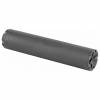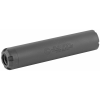Opinion
If you are new to the world of suppressors, maintenance and care might seem intimidating, but according to SilencerCo’s Chase Glenn, keeping your suppressor in top shape is simpler than you think.
In this podcast from Vortex Nation, Chase, along with hosts Mark Boardman and Scott Parks, delves into suppressor cleaning and care. Here are the key takeaways for pro-gun, well-informed enthusiasts looking to get the most out of their suppressors.
Why Suppressors Make Sense: Save the Ears!
Suppressors have grown in popularity, not just for their cool factor but for practical reasons. Scott was an early adopter, realizing their benefits, particularly in reducing sound and recoil. As a teaching tool for new shooters, suppressors dramatically reduce the flinch-inducing blast, making it easier to focus on fundamentals.
Chase mentions that SilencerCo has been a pioneer in the space for over 15 years, normalizing suppressors through innovative designs like the Sparrow, a user-serviceable suppressor. With more people entering the suppressor world, understanding how to care for these devices is important.
Breaking Down Suppressor Cleaning
Suppressor cleaning depends on the type of bullet used—whether it’s jacketed or cast. For rimfire suppressors, especially those using cast bullets, more frequent cleaning is recommended, typically after 500 to 750 rounds. For centerfire suppressors, carbon buildup happens much more slowly.
Cleaning is not about getting your suppressor sparkling clean. In fact, suppressors often shoot quieter when they’re dirty. A simple cleaning method involves soaking parts in Simple Green, a non-corrosive cleaner, for 12 to 24 hours. Then, scrape off any buildup using basic tools like a popsicle stick or pocketknife.
Practical Tips for Suppressor Care
The podcast emphasizes keeping things simple:
- Frequency: Clean after about 500 to 750 rounds for rimfire suppressors. For centerfire suppressors, cleaning is less frequent—sometimes after several thousand rounds.
- Materials to Avoid: Be cautious with materials like aluminum and titanium in ultrasonic cleaners, as they can degrade.
- Simple Tools: Simple Green and stainless steel media in a tumbler will generally get the job done without damaging the suppressor.
Specific Tips for ARs and Hard-Use Guns
Suppressors on ARs and gas guns accumulate dirt faster. New technology like low-back-pressure suppressors helps reduce the gas and carbon that blow back into the firearm. For these suppressors, Chase recommends the same Simple Green method, letting the parts soak to break down carbon buildup.
Chase also emphasizes the importance of cleaning the mounting surfaces. Carbon buildup on the threads or pistons can throw off the alignment, causing baffle strikes or accuracy issues. A quick fix is to apply high-temperature grease to the taper instead of the threads to keep everything running smoothly.
Live Inventory Price Checker

|
SILENCERCO Sparrow 22 LR Multi-Caliber Direct Thread Silencer / Suppressor - Black | KYGUNCO | $ 296.65 |
|

|
Silencerco Sparrow 22 Suppressor | Rainier Arms | $ 296.65 |
|

|
SilencerCo Sparrow 22 Suppressor .22LR 5.08 | GrabAGun | $ 296.65 |
|

|
SilencerCo Sparrow 22, .22cal, Black, Suppressor | BattleHawk Armory | $ 349.00 $ 296.65 |
|
Conclusion: Keep It Simple and Shoot More
Suppressor care doesn’t have to be complicated. Whether you’re running a rimfire or a hard-use AR, regular maintenance helps you enjoy a better shooting experience without the hassle. With Simple Green, a few basic tools, and a little attention to detail, you can keep your suppressor in optimal condition without overthinking it.
And don’t forget—many reputable manufacturers like SilencerCo offer great warranties. If your suppressor starts to act up or feels heavier than usual, contact the manufacturer for support.
If you’re passionate about shooting and enjoy learning the ins and outs of your gear, this Vortex Nation podcast serves as a solid guide to maintaining suppressor performance while keeping things low-stress.






Certainly a deep dive into suppressors, but reserve yourself an hour, because this is not a 10 Minute Talk.